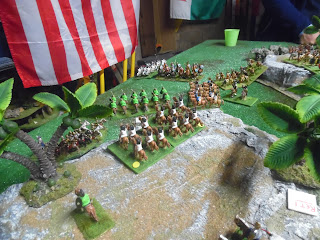Last night we had a terrific game using my 25mm E.C.W. war figures.Andy and Dave were the Royalists,whilst Brian,Graham and I were the Parliamentarians..................
Top photo is the scenario,bottom shows the initial troop dispositions-Royalists on the left.The battle begins-our plan was just to attack the defences,whilst holding the flanks with our cavalry-what could possibly go wrong??-Dave and Andy look grim(!)Action all the way-fire-fights, melees and cavalry charges-proper stuff!
This is Brian and Andy's flank-their cavalry battles went on the whole game,nip and tuck at every turn,in the background you can see Brian's Dragoons about to be ridden down by Andy's "Lobsters"
Dave and I were having our own little battle-twice he put his Brigadiers into a melee to stabilise the fight,only to get them both killed!!!-this caused the defence to collapse(you can see my "Lobsters" advancing to take advantage of the situation)-but what of the central fight?
Despite being cannistered and shot at from behind the defences,Graham did manage to breach the barricade,but then was repulsed by fresh troops! isn't war hell?? after losing all his infantry he then fell back on his guns to assist Brian who was just holding his own(steady!) by this time it was just about certain that the Royalsts couldn't hold onto their position,but Andy and Brian still had fresh troops and fought on!!
"Lobsters" shooting at a defensive knot of white coats,before taking on Dave's last cavalry regiment-he actually put the King(yes the King!) in charge of them but to no avail.We all agreed that the Royalists should retire(it's good being retired!) and the Parliamentarians declared the winners-hurrah!
This was a good game enjoyed by all-roll on next week-something very strange but maybe feasible could be on the table-we'll see!




















































